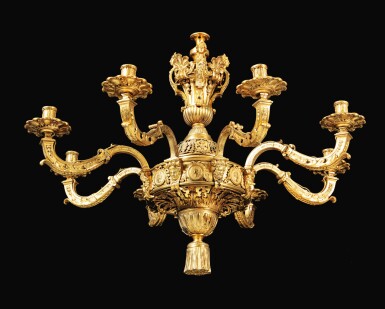Redécouvertes : important mobilier du XVIIIe siècle provenant d’une prestigieuse collection
Redécouvertes : important mobilier du XVIIIe siècle provenant d’une prestigieuse collection

A GILT-BRONZE CHANDELIER, PART RÉGENCE, REASSEMBLED AND COMPLETED IN THE FIRST HALF OF THE 19TH CENTURY, AFTER A DRAWING BY DANIEL MAROT | LUSTRE EN BRONZE DORÉ EN PARTIE D’ÉPOQUE RÉGENCE, REMONTÉ ET COMPLÉTÉ DANS LA PREMIÈRE MOITIÉ DU XIXE SIÈCLE, D’APRÈS UN DESSIN DE DANIEL MAROT
Auction Closed
June 16, 02:34 PM GMT
Estimate
30,000 - 50,000 EUR
Lot Details
Description
A GILT-BRONZE CHANDELIER, PART RÉGENCE, REASSEMBLED AND COMPLETED IN THE FIRST HALF OF THE 19TH CENTURY, AFTER A DRAWING BY DANIEL MAROT
with eight candlearms, the whole with caryatids, male and female masks and profile medallions, gadrooning, acanthus leaves and a gilt-bronze tassle
Haut. 76 cm. diam. 90 cm ; height 30 in; diam. 35½ in
---------------------------------------------------------------------------
LUSTRE EN BRONZE DORÉ EN PARTIE D’ÉPOQUE RÉGENCE, REMONTÉ ET COMPLÉTÉ DANS LA PREMIÈRE MOITIÉ DU XIXE SIÈCLE, D’APRÈS UN DESSIN DE DANIEL MAROT
à huit bras de lumière, à décor de masques masculins et féminins, et de profils dans des médaillons
The collection of René Fribourg (Part 1), Sotheby's London, 28th June 1963, Lot 151;
Private Collection, Sotheby's, New York, 27 October 1990, Lot 21.
---------------------------------------------------------------------------
Collection René Fribourg I, Sotheby's, Londres, le 28 juin 1963, lot 151
Collection particulière, Sotheby's, New York, le 27 octobre 1990, lot 21
This chandelier belongs to a group of chandeliers boasting a particular design and structure, with known fine examples in the Louvre Museum in Paris and the Victorian & Albert Museum in London. A chandelier from the Alexander Collection with a similar structure was sold Christie's, New York, 30 April, 1999, lot 124 and another from the Collection of Monsieur Louis Cartier and later in the Collection of Madame Barbara Piasecka Johnson, was sold at Sotheby's, London, 5 July, 2006, lot 4. This type of chandelier with variations to the ornament is found in engravings by Daniel Marot and designs by Jean Bérain. The differences in ornament used therefore purports that the bronzier was at liberty to choose the ornament used, with most of these chandeliers produced in a workshop similar to that of André-Charles Boulle.
Our chandelier is made up of several elements superimposed around an axis and very similar to those produced in ormolu at the beginning of the 18th century. The elements were assembled through both the cold and heated welding process. The complete dismantling of our chandelier has shown that certain elements were fashioned during the first half of the 19th century. This clearly indicates the re-using of different design components from the beginning of the 18th century, which combined with the later elements, made it possible to create lighting with bobèches which is stylistically much more Louis-Philippe than Régence, thus revealing the fashion of the time for the appreciation of the added decorative gilt-bronze trimmings.
---------------------------------------------------------------------------
Ce lustre appartient à un groupe de lustres présentant certaines différences, les versions les plus riches appartiennent au Louvre et au Victoria & Albert Museum ; un lustre présentant une structure similaire provenant de la collection Alexander a été vendu chez Christie’s à New York, le 30 avril 1999, lot 124. Un lustre similaire provenant de la collection de Monsieur Louis Cartier, puis de celle de Madame Barbara Piasecka Johnson, fut ensuite vendu chez Sotheby’s à Londres le 5 juillet 2006, lot 4 (Highlights from an Important Private Collection). Ce type de lustre apparait sur des gravures de Daniel Marot, avec des variations dans les ornements. Différences qui apparaissent également sur des projets de Jean Bérain, comme si l’ornemaniste proposait des possibilités que le bronzier pouvait choisir. Ces lustres proviennent vraisemblablement d’un même atelier se situant dans la mouvance de celui d’André-Charles Boulle.
Notre lustre, comme les lustres en bronze doré du début du XVIIIe siècle, est constitué de plusieurs éléments superposés autour d’un axe : ces pièces sont assemblées à froid ou à chaud, par soudure. Le démontage complet du lustre met en lumière que certains éléments qui le constituent ont été façonnés dans la première moitié du XIXe. Il s’agit clairement d’une réutilisation de différentes pièces du début du XVIIIe qui, associées à des éléments plus tardifs, a permis de constituer un luminaire avec des bassins et bobèches qui s’inscrivent stylistiquement comme beaucoup plus Louis-Philippe que Régence et révélatrice de la mode du moment. La passementerie qui termine le lustre conforte cette appréciation.
